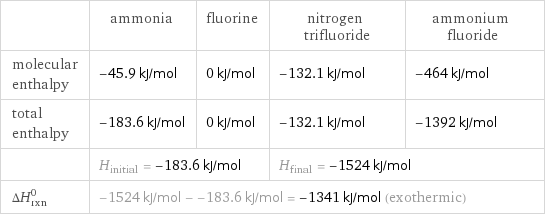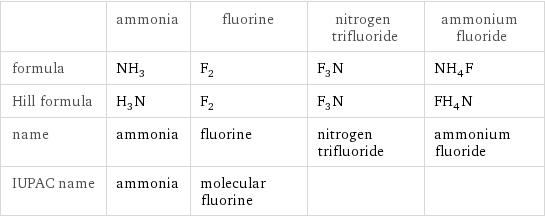Input interpretation

NH_3 ammonia + F_2 fluorine ⟶ F_3N nitrogen trifluoride + NH_4F ammonium fluoride
Balanced equation

Balance the chemical equation algebraically: NH_3 + F_2 ⟶ F_3N + NH_4F Add stoichiometric coefficients, c_i, to the reactants and products: c_1 NH_3 + c_2 F_2 ⟶ c_3 F_3N + c_4 NH_4F Set the number of atoms in the reactants equal to the number of atoms in the products for H, N and F: H: | 3 c_1 = 4 c_4 N: | c_1 = c_3 + c_4 F: | 2 c_2 = 3 c_3 + c_4 Since the coefficients are relative quantities and underdetermined, choose a coefficient to set arbitrarily. To keep the coefficients small, the arbitrary value is ordinarily one. For instance, set c_3 = 1 and solve the system of equations for the remaining coefficients: c_1 = 4 c_2 = 3 c_3 = 1 c_4 = 3 Substitute the coefficients into the chemical reaction to obtain the balanced equation: Answer: | | 4 NH_3 + 3 F_2 ⟶ F_3N + 3 NH_4F
Structures

+ ⟶ +
Names

ammonia + fluorine ⟶ nitrogen trifluoride + ammonium fluoride
Reaction thermodynamics
Enthalpy

| ammonia | fluorine | nitrogen trifluoride | ammonium fluoride molecular enthalpy | -45.9 kJ/mol | 0 kJ/mol | -132.1 kJ/mol | -464 kJ/mol total enthalpy | -183.6 kJ/mol | 0 kJ/mol | -132.1 kJ/mol | -1392 kJ/mol | H_initial = -183.6 kJ/mol | | H_final = -1524 kJ/mol | ΔH_rxn^0 | -1524 kJ/mol - -183.6 kJ/mol = -1341 kJ/mol (exothermic) | | |
Gibbs free energy

| ammonia | fluorine | nitrogen trifluoride | ammonium fluoride molecular free energy | -16.4 kJ/mol | 0 kJ/mol | -90.6 kJ/mol | -348.7 kJ/mol total free energy | -65.6 kJ/mol | 0 kJ/mol | -90.6 kJ/mol | -1046 kJ/mol | G_initial = -65.6 kJ/mol | | G_final = -1137 kJ/mol | ΔG_rxn^0 | -1137 kJ/mol - -65.6 kJ/mol = -1071 kJ/mol (exergonic) | | |
Entropy

| ammonia | fluorine | nitrogen trifluoride | ammonium fluoride molecular entropy | 193 J/(mol K) | 202.8 J/(mol K) | 260.8 J/(mol K) | 72 J/(mol K) total entropy | 772 J/(mol K) | 608.4 J/(mol K) | 260.8 J/(mol K) | 216 J/(mol K) | S_initial = 1380 J/(mol K) | | S_final = 476.8 J/(mol K) | ΔS_rxn^0 | 476.8 J/(mol K) - 1380 J/(mol K) = -903.6 J/(mol K) (exoentropic) | | |
Equilibrium constant
![Construct the equilibrium constant, K, expression for: NH_3 + F_2 ⟶ F_3N + NH_4F Plan: • Balance the chemical equation. • Determine the stoichiometric numbers. • Assemble the activity expression for each chemical species. • Use the activity expressions to build the equilibrium constant expression. Write the balanced chemical equation: 4 NH_3 + 3 F_2 ⟶ F_3N + 3 NH_4F Assign stoichiometric numbers, ν_i, using the stoichiometric coefficients, c_i, from the balanced chemical equation in the following manner: ν_i = -c_i for reactants and ν_i = c_i for products: chemical species | c_i | ν_i NH_3 | 4 | -4 F_2 | 3 | -3 F_3N | 1 | 1 NH_4F | 3 | 3 Assemble the activity expressions accounting for the state of matter and ν_i: chemical species | c_i | ν_i | activity expression NH_3 | 4 | -4 | ([NH3])^(-4) F_2 | 3 | -3 | ([F2])^(-3) F_3N | 1 | 1 | [F3N] NH_4F | 3 | 3 | ([NH4F])^3 The equilibrium constant symbol in the concentration basis is: K_c Mulitply the activity expressions to arrive at the K_c expression: Answer: | | K_c = ([NH3])^(-4) ([F2])^(-3) [F3N] ([NH4F])^3 = ([F3N] ([NH4F])^3)/(([NH3])^4 ([F2])^3)](../image_source/5f1ed91f99a02f1728c0a48be10f2444.png)
Construct the equilibrium constant, K, expression for: NH_3 + F_2 ⟶ F_3N + NH_4F Plan: • Balance the chemical equation. • Determine the stoichiometric numbers. • Assemble the activity expression for each chemical species. • Use the activity expressions to build the equilibrium constant expression. Write the balanced chemical equation: 4 NH_3 + 3 F_2 ⟶ F_3N + 3 NH_4F Assign stoichiometric numbers, ν_i, using the stoichiometric coefficients, c_i, from the balanced chemical equation in the following manner: ν_i = -c_i for reactants and ν_i = c_i for products: chemical species | c_i | ν_i NH_3 | 4 | -4 F_2 | 3 | -3 F_3N | 1 | 1 NH_4F | 3 | 3 Assemble the activity expressions accounting for the state of matter and ν_i: chemical species | c_i | ν_i | activity expression NH_3 | 4 | -4 | ([NH3])^(-4) F_2 | 3 | -3 | ([F2])^(-3) F_3N | 1 | 1 | [F3N] NH_4F | 3 | 3 | ([NH4F])^3 The equilibrium constant symbol in the concentration basis is: K_c Mulitply the activity expressions to arrive at the K_c expression: Answer: | | K_c = ([NH3])^(-4) ([F2])^(-3) [F3N] ([NH4F])^3 = ([F3N] ([NH4F])^3)/(([NH3])^4 ([F2])^3)
Rate of reaction
![Construct the rate of reaction expression for: NH_3 + F_2 ⟶ F_3N + NH_4F Plan: • Balance the chemical equation. • Determine the stoichiometric numbers. • Assemble the rate term for each chemical species. • Write the rate of reaction expression. Write the balanced chemical equation: 4 NH_3 + 3 F_2 ⟶ F_3N + 3 NH_4F Assign stoichiometric numbers, ν_i, using the stoichiometric coefficients, c_i, from the balanced chemical equation in the following manner: ν_i = -c_i for reactants and ν_i = c_i for products: chemical species | c_i | ν_i NH_3 | 4 | -4 F_2 | 3 | -3 F_3N | 1 | 1 NH_4F | 3 | 3 The rate term for each chemical species, B_i, is 1/ν_i(Δ[B_i])/(Δt) where [B_i] is the amount concentration and t is time: chemical species | c_i | ν_i | rate term NH_3 | 4 | -4 | -1/4 (Δ[NH3])/(Δt) F_2 | 3 | -3 | -1/3 (Δ[F2])/(Δt) F_3N | 1 | 1 | (Δ[F3N])/(Δt) NH_4F | 3 | 3 | 1/3 (Δ[NH4F])/(Δt) (for infinitesimal rate of change, replace Δ with d) Set the rate terms equal to each other to arrive at the rate expression: Answer: | | rate = -1/4 (Δ[NH3])/(Δt) = -1/3 (Δ[F2])/(Δt) = (Δ[F3N])/(Δt) = 1/3 (Δ[NH4F])/(Δt) (assuming constant volume and no accumulation of intermediates or side products)](../image_source/de01c675818c3ec69deca8d42912d0af.png)
Construct the rate of reaction expression for: NH_3 + F_2 ⟶ F_3N + NH_4F Plan: • Balance the chemical equation. • Determine the stoichiometric numbers. • Assemble the rate term for each chemical species. • Write the rate of reaction expression. Write the balanced chemical equation: 4 NH_3 + 3 F_2 ⟶ F_3N + 3 NH_4F Assign stoichiometric numbers, ν_i, using the stoichiometric coefficients, c_i, from the balanced chemical equation in the following manner: ν_i = -c_i for reactants and ν_i = c_i for products: chemical species | c_i | ν_i NH_3 | 4 | -4 F_2 | 3 | -3 F_3N | 1 | 1 NH_4F | 3 | 3 The rate term for each chemical species, B_i, is 1/ν_i(Δ[B_i])/(Δt) where [B_i] is the amount concentration and t is time: chemical species | c_i | ν_i | rate term NH_3 | 4 | -4 | -1/4 (Δ[NH3])/(Δt) F_2 | 3 | -3 | -1/3 (Δ[F2])/(Δt) F_3N | 1 | 1 | (Δ[F3N])/(Δt) NH_4F | 3 | 3 | 1/3 (Δ[NH4F])/(Δt) (for infinitesimal rate of change, replace Δ with d) Set the rate terms equal to each other to arrive at the rate expression: Answer: | | rate = -1/4 (Δ[NH3])/(Δt) = -1/3 (Δ[F2])/(Δt) = (Δ[F3N])/(Δt) = 1/3 (Δ[NH4F])/(Δt) (assuming constant volume and no accumulation of intermediates or side products)
Chemical names and formulas

| ammonia | fluorine | nitrogen trifluoride | ammonium fluoride formula | NH_3 | F_2 | F_3N | NH_4F Hill formula | H_3N | F_2 | F_3N | FH_4N name | ammonia | fluorine | nitrogen trifluoride | ammonium fluoride IUPAC name | ammonia | molecular fluorine | |
Substance properties

| ammonia | fluorine | nitrogen trifluoride | ammonium fluoride molar mass | 17.031 g/mol | 37.996806326 g/mol | 71.002 g/mol | 37.037 g/mol phase | gas (at STP) | gas (at STP) | gas (at STP) | solid (at STP) melting point | -77.73 °C | -219.6 °C | -207.15 °C | 160 °C boiling point | -33.33 °C | -188.12 °C | -129.1 °C | density | 6.96×10^-4 g/cm^3 (at 25 °C) | 0.001696 g/cm^3 (at 0 °C) | 0.002902 g/cm^3 (at 25 °C) | 1.0092 g/cm^3 solubility in water | | reacts | slightly soluble | surface tension | 0.0234 N/m | | | dynamic viscosity | 1.009×10^-5 Pa s (at 25 °C) | 2.344×10^-5 Pa s (at 25 °C) | |
Units
